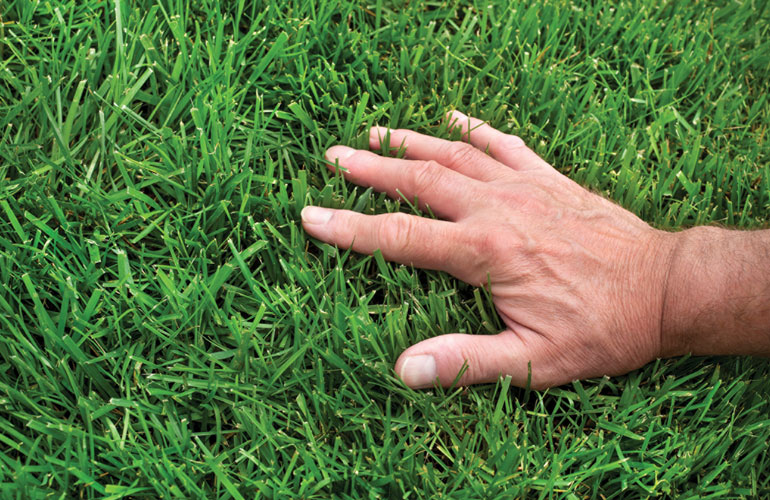Who would have thought the All-American lawn would become a hot topic of debate? One has only to read various social media posts, blogs, and news articles today to realize the “traditional lawn” is under attack. Lawns are charged with consuming more resources than the benefits they provide, requiring massive amounts of water, pesticides, and fertilizers at the expense of the environment. The amount of water, fertilizer, and chemicals used in caring for a lawn can obviously be debated. But what cannot be debated—and what is often lost or overlooked—is the importance of healthy turf ground cover. There are many ways a healthy lawn, no matter the level of inputs, benefits neighborhoods and communities.

Decreasing Erosion. A healthy stand of grass plays a crucial role in reducing soil erosion. When a thin stand of turf spans the lawn, it allows the exposed soil to erode with rain. The soil then washes off the property, carrying soil particles and nutrients that impede water flow and add to silting in our streams and ponds. Preventing soil erosion may be the most vital role a thick stand of grass provides.
Cleaning Stormwater. Like a sponge that absorbs water, a thick stand of grass slows stormwater and holds soil particles in place. The lawn additionally becomes a filter, catching sediment, slowing runoff, and resulting in less—and cleaner—stormwater entering sewers.
Reducing Noise & Glare. Research shows lawns also reduce noise by up to 40% compared to sound bouncing off hard surfaces like parking lots, streets, and homes. In addition to absorbing sound, lawns actually reduce glare. The blades of grass disperse sunlight and improve visibility on a sunny day.
Reducing Heat. During the heat of summer, lawns are 30% cooler than asphalt and 14% cooler than bare ground. Urban areas with numerous buildings and paved surfaces are 10-15% warmer than rural areas, producing a heat island effect. Grass coverings act as a natural air conditioner. Water evaporating through the grass blades has a cooling effect.
Trapping Pollutants. Lawns even help in the fight against air pollution. It is estimated as many as 12 million tons of dust and particles are released each year into the atmosphere. The dense leaf blades in a healthy lawn trap much of it.
Catching Carbon. Through photosynthesis, lawns remove carbon dioxide, storing it as organic matter, and release oxygen. A 2,500 square foot lawn absorbs enough carbon dioxide over a year to produce oxygen for a family of four. Research has shown mulching grass clippings, letting them naturally decompose on the lawn, decreases carbon release into the atmosphere by 11% to 59% over clipping removal. Additionally, the breakdown of the clippings naturally feeds the soil.
Improving Soil. Grass continually grows and generates new roots. Dying, decomposing, and regrowth of the grass builds humus improving soil’s physical and chemical properties.
Enhancing Well-Being. Finally, don’t underestimate the contribution lawns have on human health. Vegetative landscapes improve mental, physical, and emotional well-being. Hospital patients recover faster when their rooms look onto grassy areas. Where else can you get the recreational benefits of playing catch, engaging in sports, or letting your dog run freely?
The Happy Medium
As mentioned, what can be debated in lawn care is the amount of inputs required. Exactly how much irrigation, nutrition, and pest control is necessary to acquire a healthy turf ground cover? These inputs are directly related to our perception of what is a beautiful lawn. Is it a sea of uniform, green, weed-free grass? Or is it acceptable to have a few weeds popping up and a lighter green appearance?
Lawn care has become a social issue as we all fall somewhere on the environmental stewardship continuum. We must ask ourselves if we over-sold the need to water, fertilize, and control every imperfection. Continuing to promote this ideal has led to pushback and may only reinforce the perception of the lawn as environmental detriment.
We can agree there will always be a need for a lawn. But times are changing, and more Americans are making a choice—or being legally required—to use less water, chemicals, and fertilizers. Their tolerance of imperfections is growing depending, in some part, on their region’s climate challenges and awareness. Here are a few key areas to watch:
Water Conservation. Water and its usage will become our greatest challenge. We are already seeing many communities restricting water use for lawns. This will expand to other communities in the future. When it comes to water, it should be acceptable to let lawns go dormant during stressful periods. Depending on your location, lawns can survive on reduced water use during stressful periods. Dormant lawns brown-out, but revive once acceptable growing conditions return. There is fine line between a lawn in dormancy and dieback. This is a management strategy acceptable to many attempting to reduce both the input of water and the added expense.
Organic Fertilizer Use. There is an increasing demand for organic fertilizer alternatives that build soil health. Plants don’t care about the source they utilize; people do. More people are now looking at the minimum, not the maximum, amount of fertilizer to apply for an adequate cover, and want its application to have environmental benefits.
Weed Tolerance. For a growing number of people, dandelions and white clover are no longer a source of neighborhood shame. Instead, these cheery yellow and white flowers are a beacon for a healthy ground cover. Dandelions are one of the best sources of nectar for early emerging bees before other flowers open. The shift away from certain weed killing chemicals will continue as tolerance of less-than-perfect lawns is seen as providing benefits to the environment, particularly at-risk pollinators.
Make no mistake, the future of the lawn is still ensured. We will always need a place to relax and play. But times are changing on the definition of an ideal lawn. These changes should be embraced and accepted. It’s not us versus them. We all benefit when we develop an inclusive dialogue about our shared value of the All-American lawn.
 Patton is a horticulture agent with over 35 years of experience with the Johnson County Kansas State University Agricultural Experiment Station and Cooperative Extension Service. He has a BS in Horticulture and an MS in Adult Education, but adds, “Like most people, my best education has come from working in the industry.” Information and statistics from the article can be found in: Benefits of Healthy Turf – Kansas State Extension; and Environmental Benefits of a Healthy Turf – University of Minnesota Extension.
Patton is a horticulture agent with over 35 years of experience with the Johnson County Kansas State University Agricultural Experiment Station and Cooperative Extension Service. He has a BS in Horticulture and an MS in Adult Education, but adds, “Like most people, my best education has come from working in the industry.” Information and statistics from the article can be found in: Benefits of Healthy Turf – Kansas State Extension; and Environmental Benefits of a Healthy Turf – University of Minnesota Extension.
Do you have a comment? Share your thoughts in the Comments section below, or send an e-mail to the Editor at acosgrove@groupc.com.











![[VIDEO] Dickies®: Discover Workwear That’s Anything But Uniform](https://turfmagazine.com/wp-content/uploads/2023/06/1647663814-4b1a2a7742790a9b1e97a3b963477850192e1d6a9dfba9b07214a77bae25d6e3-d-218x150.jpg)






























![[VIDEO] Dickies®: Discover Workwear That’s Anything But Uniform](https://turfmagazine.com/wp-content/uploads/2023/06/1647663814-4b1a2a7742790a9b1e97a3b963477850192e1d6a9dfba9b07214a77bae25d6e3-d-324x160.jpg)
Great article! This issue needs to be addressed.
Great article. What about all the water used in washing automobiles. This information has to be shared.
Could not agree more. Great article:-)